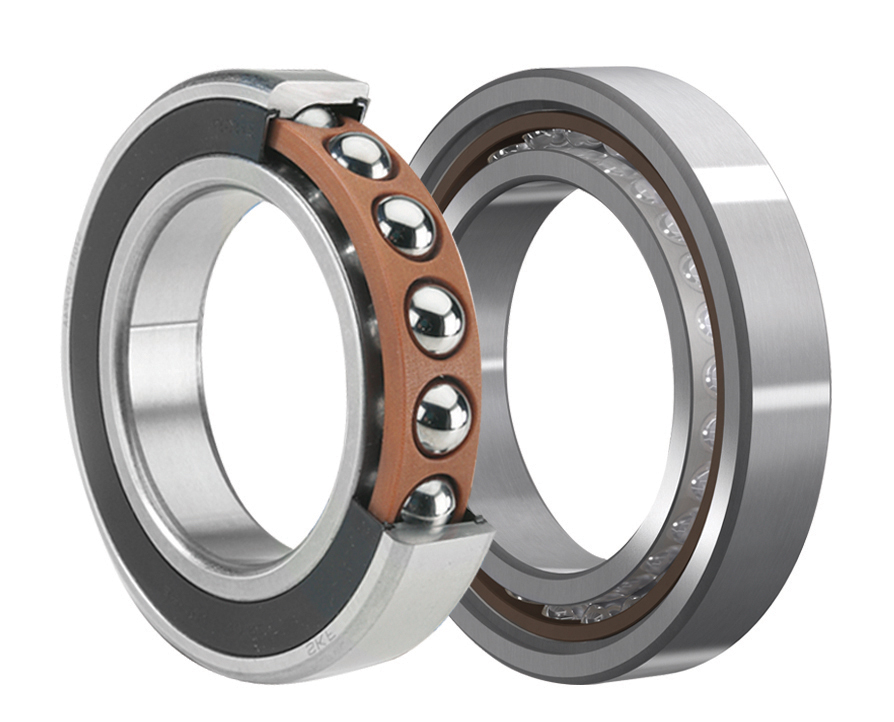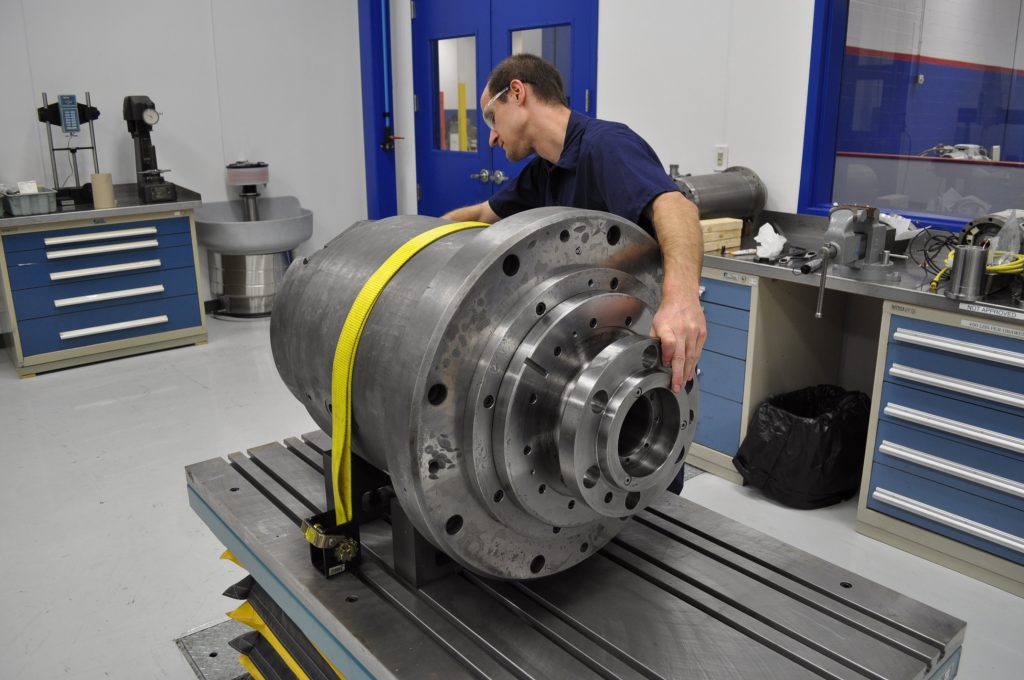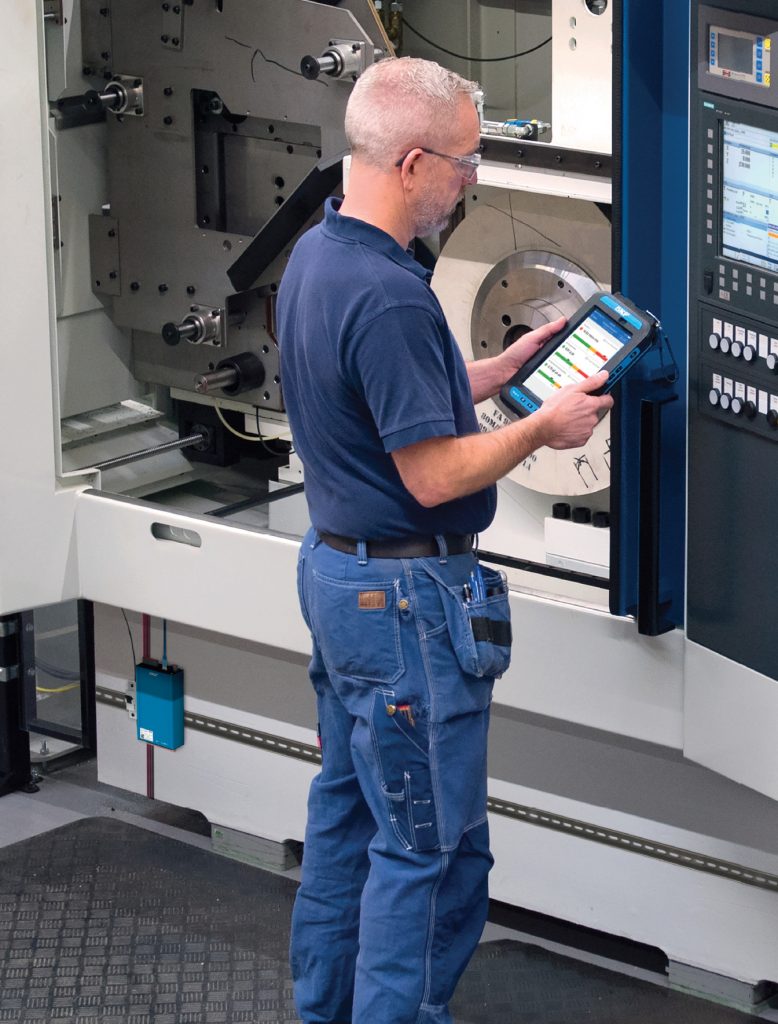Machine tools appropriately equipped to deliver high performance, speed, precision, and reliability can help promote production efficiencies and profitability for any operation. Every machine tool component and protocol – from bearings to maintenance – ultimately influences application success.
With the exceptional operating demands placed on machine tools, enabling technologies have kept pace with the needs.
Notable examples (among many) include super-precision bearings to achieve higher speeds and higher load carrying capacity compared with standard bearings; dedicated remanufacturing and upgrade services to extend service life for spindles at risk; and condition monitoring devices and systems to ascertain the health of machinery and allow for timely fixes at the earliest signs of impending failure.
 Super-Precision Bearings
Super-Precision Bearings
For any machine tool, extended speed capabilities, a high degree of running accuracy, high system rigidity, low heat generation, and low noise and vibration represent critical requirements. Super-precision bearings (in numerous executions) can play vital roles.
Engineered for machine tool applications, including spindles, super-precision bearings feature innovative cage designs and materials and clean bearing steel to develop the necessary higher speeds and high load carrying capacity. Hybrid versions as variations combine steel rings and bearing-grade silicon nitride (ceramic) for rolling elements to achieve higher load capacity with low friction and low heat characteristics promoting high-speed operation.
As just one example of types for machine tool applications, angular contact ball bearings particularly can handle the loading requirements, among other key advantages. A wide assortment of designs and variants, including sealed and non-sealed versions, expands the portfolio.
Exemplifying how far such bearings have evolved, a series of super-precision angular contact thrust ball bearings especially suit machine tool screw drives by providing safer radial and axial support, precise axial guidance of shafts, and accommodating high acceleration and high speed.
Since machine tools require screw drives that can position a work piece or machine component quickly, efficiently, and precisely, screw drives are usually supported by bearings at both ends – ideal locations for super-precision types, in general, and angular contact thrust ball bearings, in particular.
Angular contact thrust ball bearings have been shown to exhibit high stiffness and high load-carrying capacity, generate less friction, and can accommodate high speeds and rapid acceleration typically encountered in machine tool applications. Their engineering promotes extended bearing service life, minimized maintenance, and reduced energy consumption.
Features include fine-tuned osculation, 62º contact angle, ground transition between raceway and shoulder, robust cage, unique heat treatment for constant preload over the entire service life, tightened manufacturing tolerances to provide excellent running and dimensional accuracy, and seals or shields offering protection against contaminants in harsh conditions.
Single direction versions allow for various bearing set arrangements and double direction bearings can reduce the number of components in an assembly. The bearings can also be incorporated into cartridge units with flanged housing or sealed for operation in harsh environments.
From a system perspective, sealed pre-greased versions are becoming more common in screw drive applications. Sealed bearings, which use low-friction seals, have virtually eliminated the need to order bearings or bearing sets with a special seal configuration on one side or the other. Added advantages: no risk of over- or under-greasing a bearing, reduced risk of grease contamination, and reduced need for maintenance attention.
 Spindle Rebuilds and Upgrades
Spindle Rebuilds and Upgrades
When performed correctly, the remanufacturing of industrial equipment and components can be a practical, cost-effective, timely, and environmentally friendlier alternative to outright replacement. Whether refurbishing, repairing, reconditioning, reworking, rebuilding, and/or upgrading, the restoration of failing or threatened assets can help fast-track operations back to productivity.
Turning to spindles – the heart of a machine tool – these precision components especially represent prime candidates for repair and rebuild services should performance problems arise.
Machine tool spindles typically are used to rotate cutting tools, grinding wheels, or parts to be machined in applications ranging from milling, drilling, and boring to grinding, cutting, and sawing. Spindles are engineered to deliver high levels of speed, accuracy, precision, and repeatability and, ultimately, they represent complex systems integrating dozens of critical components that will impact machine tool performance.
As with any critical asset, however, spindles can fail for any number of reasons, whether due to contaminants, loss or increase of preloads, lubrication issues, improper care and maintenance, or even using an inappropriate spindle design for an application.
When failure occurs, outright replacement can cost outsized amounts of time and money. While a new spindle may be in a local dealer’s stock, on average the lead-time for delivery of a new replacement spindle can run as long as 24 weeks with productivity grinding to a standstill during the wait. The price tag for a new spindle, too, can be steep (sometimes averaging as much as triple the cost of a remanufactured unit). Such numbers make strong cases supporting remanufacturing over replacement.
As a viable and practical alternative to spindle replacement, remanufacturing is an increasingly preferred option – and spindles can be remanufactured many times over without adverse consequences.
Dedicated services as provided by SKF include advanced spindle analysis and testing, parts repair and manufacture, engineering, balancing of spindle components and complete assemblies, upgrades, and custom modifications, among other areas. Quality control is built into every phase of repair work, which is grounded in defined procedures and processes with the objective to return spindles to active duty as quickly as possible.
Spindles undergoing remanufacture also can be prime candidates for customization or upgrades that can add value and expand application potential. Spindles can be customized or upgraded any time, but when a spindle moves into remanufacture, it usually makes economic (and timely) sense to seize the opportunity.
Depending on the spindle application, upgrades may be as simple as adding an air purge to keep the bearings and the inside of the spindle free of contamination or replacing standard steel bearings with hybrid ceramic bearings to improve life or increase speed. Major upgrades can encompass multiple changes delivering newfound spindle capabilities. Customization can uniquely tailor a spindle to application demands.
While in some cases replacement of a spindle may be unavoidable, remanufacturing can deliver a relatively quick and cost-effective return of a spindle to productivity.
Condition Monitoring Techniques
Condition monitoring technologies enable early detection of operating abnormalities in rotating equipment with the objective to make fixes before problems escalate. While periodic surveillance of machinery health will usually be sufficient for relatively non-critical assets, machines considered “too critical to fail” represent candidates for more frequent and/or continuous monitoring. Machine tools often will be ranked at the top of the list.
 Condition monitoring solutions include a range of options from basic handheld or stand-alone data collectors to more sophisticated, connected, and networked systems.
Condition monitoring solutions include a range of options from basic handheld or stand-alone data collectors to more sophisticated, connected, and networked systems.
Basic options include the SKF Spindle Assessment Kit for reliable, simplified, onboard condition monitoring. The kit includes an SKF Microlog for data collection and guidance, acceleration sensor, laser tachometer, dial gauge with stand, belt tension gauge and a software package. SKF assists in the setup of measuring points on targeted machine tool spindles and also offers a consulting service.
For especially critical machine tools, a continuous monitoring approach may be more appropriate. On-line systems (such as the SKF Multilog On-Line System IMx-8) deliver up-to-the-minute information – collecting data 24/7 or over a predetermined data-collection frequency via permanently mounted sensors and then transmitting that data (using either hardwired or wireless systems) to a host computer running relevant software packages.
Abnormalities in machine operation and performance will be detected based on measurements of various physical operating parameters, including vibration, temperature, and others. The mounted sensors and compatible software ultimately can uncover issues and allow for timely analysis and pre-emptive remedial fixes before it’s too late.
Such systems can further connect with cloud services for storing and sharing data and for accessing expert reporting and recommendations from a remote diagnostic services location. The capability to connect with mobile devices and laptops allows for user-friendly configuration and real-time display of machine condition data.
Machine condition monitoring technologies have further diversified with the advent of wireless systems. As an example, a compact, self-contained, and battery-powered wireless on-line system can be deployed to broaden 24/7 monitoring coverage, monitor “bad actors,” troubleshoot, supplement walk-around routes, enable remote monitoring, and/or provide “end of life” tracking of failing components, such as bearings. The monitoring units can easily be relocated whenever and wherever needed.
Many more technologies can be applied to help optimize machine tools in service, including customized sealing solutions, automatic lubrication systems, coolant pumps, and others. Partnering with experienced experts well-versed in the world of machine tools can reinforce any proactive effort to keep these assets serving as intended.











































